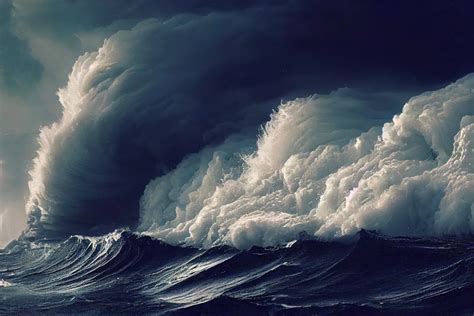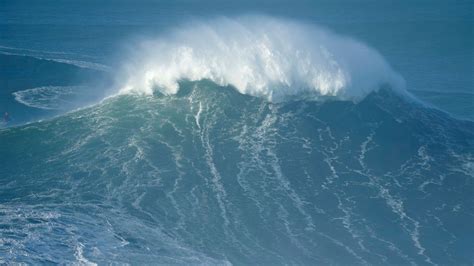
A massive rogue wave, estimated to be nearly 60 feet high, was captured on video in the Pacific Ocean near Vancouver Island, British Columbia, sending shockwaves through the scientific community. MarineLabs, a company that operates a network of sensors on the ocean, recorded the unprecedented event on November 17, 2020, characterizing it as an extreme rogue wave, an event significantly larger than surrounding waves.
The rogue wave, measured by a sensor buoy, registered at 17.6 meters (approximately 58 feet), towering over the typical wave height in the area, which was around 6 meters (about 20 feet) at the time. Researchers suggest that this event, while extreme, highlights the potential dangers posed by rogue waves to maritime activities and coastal communities, further emphasizing the need for improved monitoring and forecasting systems.
The Unprecedented Measurement
While rogue waves are not uncommon, this particular event stands out due to its sheer size relative to the ambient sea state. Dr. Johannes Gemmrich, a research scientist at the University of Victoria, explained that the rogue wave was “extreme,” defined as being more than twice the size of the significant wave height. In this case, the rogue wave was nearly three times the size of the surrounding waves, making it a statistically rare and significant occurrence. This makes it “the most extreme rogue wave ever recorded,” according to Scott Beatty, CEO of MarineLabs.
The data was collected by one of MarineLabs’ sensor buoys, which are equipped with advanced technology to measure wave height, frequency, and other oceanographic parameters. These buoys play a crucial role in monitoring ocean conditions and providing valuable data for research and forecasting. The location of the rogue wave, off the coast of Vancouver Island, is known for its rough seas and unpredictable weather patterns, making it a prime area for rogue wave formation.
Understanding Rogue Waves: A Deeper Dive
Rogue waves, also known as freak waves or killer waves, are large, unexpected, and suddenly appearing surface waves that can be extremely dangerous, even to large ships. They are not tsunamis, which are caused by underwater earthquakes or landslides, but rather are individual waves that can occur in any ocean or sea.
The formation of rogue waves is a complex phenomenon that is not yet fully understood, but several factors are believed to contribute to their occurrence. One factor is constructive interference, where multiple smaller waves merge together to form a single, larger wave. This can happen when waves traveling in different directions meet, or when waves are focused by ocean currents or underwater topography.
Another factor is nonlinear effects, which can cause waves to grow rapidly in certain conditions. These effects are particularly important in deep water, where waves can travel long distances without losing energy. Wind also plays a crucial role. Strong winds blowing against the current can steepen waves, making them more prone to breaking and forming rogue waves.
The Impact of Rogue Waves on Maritime Activities
Rogue waves pose a significant threat to maritime activities, including shipping, fishing, and offshore oil and gas operations. Their sudden appearance and immense size can overwhelm even the most robust vessels, leading to structural damage, loss of cargo, and even capsizing.
Numerous incidents have been attributed to rogue waves over the years, highlighting the dangers they pose. For example, the MS München, a German cargo ship, disappeared in the North Atlantic in 1978, and it is believed that a rogue wave may have been responsible for its sinking. In another incident, the Queen Mary 2, a large passenger liner, encountered a rogue wave in the North Atlantic in 2003, which caused significant damage to the ship’s windows and navigation equipment.
The economic impact of rogue waves can also be substantial. Damage to ships and cargo can result in significant financial losses, and the disruption of maritime trade can have broader economic consequences. In addition, the cost of search and rescue operations following rogue wave incidents can be considerable.
The Role of Monitoring and Forecasting
Given the dangers posed by rogue waves, improved monitoring and forecasting systems are essential for mitigating their impact on maritime activities. MarineLabs’ network of sensor buoys represents a significant step forward in this area, providing real-time data on wave conditions that can be used to detect and track rogue waves.
Other technologies are also being used to monitor and forecast rogue waves, including satellite radar altimeters and wave models. Satellite radar altimeters can measure wave height from space, providing a global overview of ocean conditions. Wave models use computer simulations to predict wave behavior, taking into account factors such as wind, currents, and topography.
While these technologies have improved our ability to monitor and forecast rogue waves, there is still much work to be done. Rogue waves are inherently unpredictable, and it is difficult to provide accurate warnings in advance. However, ongoing research and development efforts are focused on improving our understanding of rogue wave formation and developing more reliable forecasting tools.
The Significance of the Vancouver Island Event
The rogue wave recorded off the coast of Vancouver Island is significant for several reasons. First, it is one of the largest rogue waves ever recorded, providing valuable data for researchers studying these phenomena. Second, it highlights the potential dangers posed by rogue waves in this region, which is a major shipping route. Finally, it underscores the importance of investing in improved monitoring and forecasting systems to protect maritime activities and coastal communities.
The data collected by MarineLabs is being used to improve wave models and develop more accurate forecasting tools. By studying the characteristics of this and other rogue waves, researchers hope to gain a better understanding of the factors that contribute to their formation and develop strategies for mitigating their impact.
The Future of Rogue Wave Research
The study of rogue waves is an ongoing and evolving field. Researchers are using a variety of tools and techniques to investigate these phenomena, including field measurements, laboratory experiments, and computer simulations.
One area of focus is on developing more accurate wave models that can predict the occurrence of rogue waves. These models need to take into account a wide range of factors, including wind, currents, topography, and nonlinear effects. Researchers are also working on developing better methods for detecting rogue waves in real time, using technologies such as radar and satellite imagery.
Another area of focus is on understanding the impact of rogue waves on maritime structures. Researchers are conducting experiments to study the forces exerted by rogue waves on ships and offshore platforms, and developing design guidelines for making these structures more resistant to rogue wave damage.
The ultimate goal of rogue wave research is to develop strategies for mitigating their impact on maritime activities and coastal communities. This includes improving monitoring and forecasting systems, developing better warning systems, and designing more resilient maritime structures. By continuing to invest in research and development, we can reduce the risks posed by rogue waves and protect the lives and livelihoods of those who depend on the ocean.
Expert Opinions and Perspectives
Several experts have weighed in on the significance of the Vancouver Island rogue wave and its implications for maritime safety.
Dr. Jim Thomson, an oceanographer at the University of Washington, emphasized the importance of understanding the dynamics of rogue waves. “Rogue waves are rare events, but they can have devastating consequences,” he said. “By studying these waves, we can learn more about the processes that lead to their formation and develop strategies for mitigating their impact.”
Captain John Smith, a seasoned mariner with over 30 years of experience, stressed the need for vigilance and preparedness. “Rogue waves can appear out of nowhere, and they can be incredibly dangerous,” he said. “It’s important for mariners to be aware of the risks and to take precautions to protect themselves and their vessels.”
The consensus among experts is that rogue waves pose a significant threat to maritime activities and that continued research and development are essential for improving our ability to monitor, forecast, and mitigate their impact.
Impact on Coastal Communities
While the rogue wave occurred offshore, the potential impact on coastal communities is a serious consideration. Though this particular wave did not directly impact the coastline in a damaging way, larger rogue waves closer to shore could cause significant flooding and erosion, damage infrastructure, and pose a threat to human life. Understanding the frequency and potential size of rogue waves in different coastal regions is crucial for developing effective coastal management strategies. This includes implementing early warning systems, constructing coastal defenses, and educating the public about the risks. The Vancouver Island event serves as a reminder of the need for ongoing monitoring and research to better understand the potential hazards posed by rogue waves to coastal communities worldwide.
Technological Advancements in Wave Monitoring
The ability to detect and measure rogue waves has been significantly enhanced by technological advancements in wave monitoring systems. MarineLabs’ use of sensor buoys equipped with advanced sensors is a prime example of this progress. These buoys can collect real-time data on wave height, frequency, direction, and other oceanographic parameters, providing valuable information for understanding wave behavior and identifying potential rogue wave events.
In addition to sensor buoys, other technologies are being used to monitor waves, including satellite radar altimeters, high-frequency radar systems, and acoustic Doppler current profilers (ADCPs). Satellite radar altimeters can measure wave height from space, providing a global overview of ocean conditions. High-frequency radar systems can measure wave direction and speed from shore, providing detailed information about wave patterns in coastal areas. ADCPs can measure current speed and direction at different depths, providing insights into the dynamics of wave propagation.
The integration of these different technologies into comprehensive wave monitoring networks is crucial for improving our ability to detect and forecast rogue waves. By combining data from multiple sources, researchers can develop a more complete picture of ocean conditions and identify potential rogue wave events before they occur. The use of machine learning and artificial intelligence algorithms to analyze wave data is also showing promise in improving rogue wave detection and forecasting accuracy.
Global Implications and Future Research Directions
The occurrence of the 60-foot rogue wave off the coast of Vancouver Island has global implications for maritime safety and coastal management. Rogue waves can occur in any ocean or sea, and their potential impact on shipping, fishing, offshore oil and gas operations, and coastal communities is a concern worldwide.
The Vancouver Island event highlights the need for improved monitoring and forecasting systems in all regions prone to rogue waves. This includes deploying more sensor buoys, enhancing satellite radar altimeter coverage, and developing more accurate wave models. International collaboration is essential for sharing data and expertise and for coordinating research efforts.
Future research directions in rogue wave studies include:
- Improving our understanding of rogue wave formation mechanisms: This involves investigating the role of factors such as constructive interference, nonlinear effects, wind, and currents in the generation of rogue waves.
- Developing more accurate wave models: This requires incorporating more realistic representations of ocean physics and improving the resolution of the models.
- Enhancing rogue wave detection capabilities: This involves developing new technologies for detecting rogue waves in real time, such as radar and satellite imagery.
- Assessing the impact of climate change on rogue wave frequency and intensity: This requires studying the effects of rising sea levels, changing wind patterns, and altered ocean currents on rogue wave formation.
- Developing strategies for mitigating the impact of rogue waves: This includes improving warning systems, designing more resilient maritime structures, and implementing effective coastal management strategies.
By continuing to invest in research and development, we can reduce the risks posed by rogue waves and protect the lives and livelihoods of those who depend on the ocean.
The Human Element: Mariners’ Experiences with Rogue Waves
Beyond the scientific data and technological advancements, it is crucial to acknowledge the human element involved in encounters with rogue waves. Mariners who have experienced these events firsthand often describe them as terrifying and life-threatening. The sudden appearance of a massive wave, often much larger than any other wave in the vicinity, can overwhelm even the most experienced sailors.
Stories from survivors often recount the sheer force of the wave, the feeling of being completely helpless, and the struggle to maintain control of their vessel. Some describe the wave as a “wall of water” that appeared without warning, while others recall the deafening roar as the wave crashed over their ship.
These experiences highlight the importance of preparedness and training for mariners. Knowing how to react in the event of a rogue wave encounter can be the difference between survival and disaster. This includes securing cargo, reducing speed, and maneuvering the vessel to minimize the impact of the wave. Regular drills and simulations can help mariners develop the skills and confidence needed to handle these challenging situations.
Furthermore, providing support and counseling to mariners who have experienced rogue waves is essential. The psychological impact of such events can be significant, and it is important to offer resources to help them cope with the trauma.
The Legal and Insurance Implications of Rogue Wave Incidents
Rogue wave incidents can have significant legal and insurance implications for ship owners, operators, and insurers. Determining liability for damages or injuries caused by rogue waves can be complex, as it often involves assessing factors such as the seaworthiness of the vessel, the negligence of the crew, and the predictability of the wave event.
In many cases, rogue wave incidents are considered to be acts of God, which can limit the liability of the ship owner or operator. However, if it can be proven that the vessel was not properly maintained or that the crew acted negligently, liability may be assigned.
Insurance policies for ships typically cover damage caused by perils of the sea, which may include rogue waves. However, the specific terms and conditions of the policy will determine the extent of coverage. Insurers may require detailed information about the incident, including weather conditions, wave measurements, and the vessel’s course and speed.
The legal and insurance implications of rogue wave incidents underscore the importance of proper risk management practices for maritime operators. This includes maintaining vessels in good condition, providing adequate training for crews, and obtaining appropriate insurance coverage.
Data Analytics and Machine Learning in Predicting Rogue Waves
The increasing availability of oceanographic data has opened new avenues for utilizing data analytics and machine learning techniques to improve rogue wave prediction. Traditional wave models, while valuable, often struggle to capture the complex nonlinear dynamics that contribute to rogue wave formation. Machine learning algorithms, on the other hand, can learn from vast datasets and identify patterns that may not be apparent through traditional methods.
Researchers are exploring various machine learning approaches, including neural networks, support vector machines, and decision trees, to predict rogue wave occurrences based on factors such as wave height, wave period, wave direction, wind speed, and sea surface temperature. These algorithms can be trained on historical data to identify conditions that are conducive to rogue wave formation and provide real-time warnings to mariners.
The use of data analytics and machine learning in rogue wave prediction is still in its early stages, but the initial results are promising. As more data becomes available and algorithms are refined, these techniques have the potential to significantly improve our ability to forecast rogue waves and mitigate their impact on maritime activities.
The Role of Citizen Science in Rogue Wave Monitoring
While sophisticated technological tools are essential for rogue wave monitoring, citizen science can also play a valuable role in collecting data and raising awareness about these phenomena. Mariners, coastal residents, and recreational boaters can contribute to rogue wave monitoring by reporting unusual wave events, sharing photographs and videos, and providing information about local weather conditions.
Citizen science initiatives can help to fill gaps in official monitoring networks and provide valuable insights into rogue wave occurrences in different regions. By engaging the public in data collection and analysis, these initiatives can also raise awareness about the dangers of rogue waves and promote safer maritime practices.
Organizations such as the National Oceanic and Atmospheric Administration (NOAA) and the World Meteorological Organization (WMO) have developed resources and guidelines for citizen scientists who are interested in contributing to wave monitoring efforts. These resources provide information about how to identify and report unusual wave events, as well as how to use smartphone apps and other tools to collect data.
The Future of Ocean Exploration and the Study of Extreme Events
The discovery and documentation of the 60-foot rogue wave off Vancouver Island highlight the importance of continued ocean exploration and research. The ocean remains a vast and largely unexplored frontier, and there is much that we still do not understand about its complex dynamics.
Investing in ocean exploration and research is essential for improving our understanding of extreme events such as rogue waves, tsunamis, and hurricanes. This includes developing new technologies for ocean observation, supporting research projects, and promoting international collaboration.
The study of extreme events is not only important for protecting human lives and property, but also for understanding the Earth’s climate system and the impact of human activities on the ocean. By continuing to explore and study the ocean, we can gain a better understanding of the forces that shape our planet and develop strategies for mitigating the risks posed by extreme events.
Frequently Asked Questions (FAQ) about Rogue Waves
Q1: What exactly is a rogue wave?
A: A rogue wave, also known as a freak wave or killer wave, is a large, unexpected, and suddenly appearing surface wave that can be extremely dangerous, even to large ships. They are defined as waves whose height is more than twice the significant wave height of the surrounding waves. They are not tsunamis, which are caused by underwater earthquakes or landslides.
Q2: How are rogue waves formed?
A: The formation of rogue waves is a complex phenomenon that is not yet fully understood. However, several factors are believed to contribute to their occurrence, including constructive interference (where multiple smaller waves merge), nonlinear effects (which cause waves to grow rapidly), and the focusing of wave energy by ocean currents or underwater topography. Wind also plays a role, especially strong winds blowing against the current.
Q3: Where do rogue waves typically occur?
A: Rogue waves can occur in any ocean or sea, but some regions are more prone to them than others. These include areas with strong currents, such as the Agulhas Current off the coast of South Africa, the Gulf Stream in the North Atlantic, and the waters around Vancouver Island, British Columbia, where the 60-foot rogue wave was recorded. Areas with converging wave patterns or complex seafloor topography can also be hotspots for rogue wave formation.
Q4: Can rogue waves be predicted or forecast?
A: Predicting rogue waves is a significant challenge, as they are inherently unpredictable. However, researchers are working on developing more accurate wave models and detection systems that can provide warnings of potential rogue wave events. These systems use data from sensor buoys, satellites, and other sources to monitor wave conditions and identify patterns that may indicate the formation of a rogue wave. While reliable, precise prediction remains elusive, improved monitoring and modeling are making progress.
Q5: What should mariners do if they encounter a rogue wave?
A: If a mariner encounters a rogue wave, the most important thing to do is to take immediate action to protect themselves and their vessel. This may include reducing speed, securing cargo, and maneuvering the vessel to minimize the impact of the wave. It is also important to remain calm and assess the situation after the wave has passed, and to report the incident to the appropriate authorities. Training and preparedness are essential for mariners to effectively respond to rogue wave encounters.
The discovery of the massive rogue wave near Vancouver Island serves as a stark reminder of the power and unpredictability of the ocean. Continued research, improved monitoring, and increased awareness are crucial for mitigating the risks posed by these extreme events and protecting the lives and livelihoods of those who depend on the sea.








